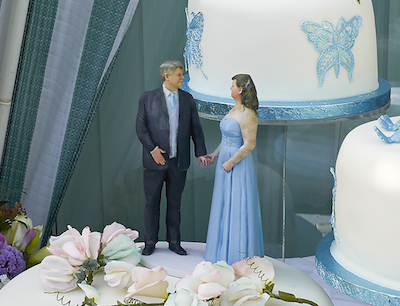When Simon Eccles married in the summer, he wanted the latest printing technology on the wedding cake.
As soon as Digital Printer’s former editor and long-standing contributor Simon Eccles saw 3D scans and full-colour figurines of real people, he realised it would make an eye-catching cake topping for his forthcoming wedding.
Last year he visited iMakr, a 3D printing specialist in London’s Clerkenwell area. The company had just got together with LGS (formerly called London Graphic Services) to set up Mini-You, a 3D scanning and printing service that it puts into upmarket London stores including Selfridges and Harvey Nicols.
He realised that this would work a treat for figures of himself and his bride-to-be Rosalind, dressed in their actual wedding finery, as the cake centrepieces. ‘I’ve worked in and written about the conventional 2D printing industry, as well as photography, for many years,’ he said. ‘I have always been intrigued by both stereoscopic photography and 3D printing. It seemed appropriate that a printing industry journalist should use the latest print technology for such a public event as his wedding!’
He contacted John Robertson, the 3D specialist at LGS, which is now exploring 3D printing as a potential future direction. It is establishing a dealership for the printers made by 3D Systems. Director Carol Brown said: ‘I genuinely believe there’s a market there for us. From our perspective there are plenty of questions we could plant in people’s minds about what they could be doing with 3D. We’re now starting to reach out to our client base in a more structured way.’
LGS bought a £51,900 3DS ProJet 660Pro as a demo machine and installed it in the basement of iMakr, to output full colour objects captured by a portable, multi-camera scanning booth containing 50 digital SLR cameras that capture all angles at the same time. This is the Mini-You service.
Some logistical acrobatics were needed to make sure that Simon – true to tradition – did not see the bride’s wedding dress before the big day, with the pair being scanned separately, but a week later the 3D figures were delivered in a sturdy wooden display box to Rosalind’s house. ‘It was really spooky when I first unpacked them and saw just how realistic they are,’ said Rosalind.
Given that weddings and other ‘event’ occasions are the mainstay of digitally printed 2D photobooks and other photo products, could there be a crossover potential for printers here?
One of the big attractions of digital photobooks to printers is the high margins on low volumes. A wedding album typically costs £15 to £30 to make even with hand binding, but can sell for £100, £200 or more with few quibbles from customers. The iMakr Mini-You figures start at £249 for the smallest size, 20 cm high, and margins seem to be healthy.
A scanning booth could almost be a DIY job, costing say £20,000 for 50 cameras and a few more thousands for the framework, lighting and electronics. The software and operators with 3D skills would be the other significant costs.
Ken Whild is southern region sales manager for HK Technologies, a UK seller of Stratasys 3D printers: ‘There are growing expectations for the events business – weddings, anniversaries and so on, so this could be a market for 3D. I’ve also been to events printers who are looking at things like personalised jewellery charms, where 3D printing could be used in the mould creation.’
The education thesis and dissertation market is already a healthy market for 2D printing, and many craft or engineering theses need a model to go with them. ‘Colleges may have their own 3D printers, but they become overloaded at thesis time. Quick printers may be able to handle this too. I know of seven copy centres in London that have been approached by students asking for 3D prints because their universities don’t have the capacity.’
For Simon and Rosalind, it all came together perfectly. His first view of the wedding dress was when the bride arrived at the church, and his second view was of the 3D figures on the cake when they arrived at the reception.
‘The figures are about 16 cm high and the detail is amazing,’ said Simon. ‘Rosalind had lace sleeves on her dress which show up perfectly. It even shows the engagement ring on her left hand – perhaps I should paint in a wedding ring now!’





